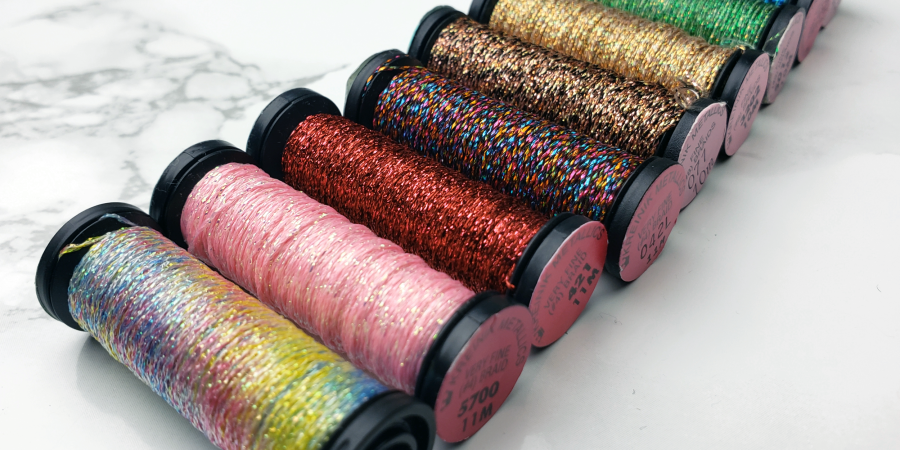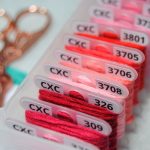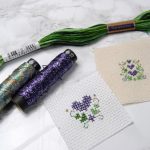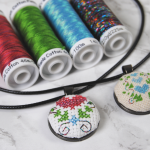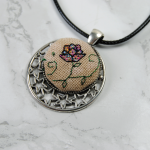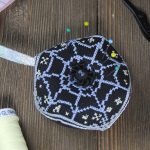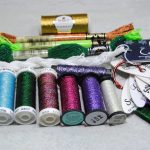Kreinik is one of my favorite metallic threads to work with, and I’ve been wanting to write this article for quite some time. I just wanted a bit more experience with other metallic threads first. At this point I’ve worked with DMC Light Effects, DMC Diamant, DMC Mouline Etoile, Lecien Cosmo Nishikiito, Rainbow Gallery Petite Treasure Braid, Sulky Metallics and Holoshimmer, Threadworx, Snow by Caron, Bijoux, and Accentuate. Yet I keep coming back to Kreinik, and can officially claim it as my favorite metallic thread to work with. So let’s discuss this brand and its pros and cons so you can make an informed decision as well.
Before we get into this I do have a little disclaimer though. I am not sponsored, and Kreinik has not asked me to write this. But I have received free product from them in the past. I’ve done a number of giveaways over the years with said provided product, as well as putting together resources such as the Discontinued DMC post where I’ve listed Kreinik alternatives for discontinued DMC Light Effects. However, I’ve been using Kreinik for decades now. Well before receiving any free product. My opinions are my own.
I’ve mentioned Kreinik already in the Glow in the Dark article, as well as when talking about Blending Filament. But they really deserve their own article, as there’s a lot to cover! Be sure to use the table of contents to skip ahead to the parts you’re most interested in.
This post may contain affiliate links. If you buy something using one of these links, I earn a small commission. However, there is no extra cost to you. Thanks for understanding! Learn more in my Disclosures & Privacy Policy.
Table of Contents
Kreinik’s History
Kreinik is a family owned business that began back in the 1970’s. They found that there was a need for less expensive and easier to care for metallic thread, and they certainly filled that need.
The original thread line created was named Balger, and you may still see that on some packaging. Now the thread line is instead divided into various sizes and types of thread. We’ll be going over several of those in just a little bit, but just know you may still find reference to Balger in older patterns. You can typically figure out which size they meant based on context, as detailed on Kreinik’s own site in the article “What to do if you need Balger“
They’ve grown well past that initial line of blending filaments and their thread is used in needlework, crochet, weaving, fashion, costuming, and fly fishing. You can even find their thread being used in film and tv for intricate costumes, such as the detailed embroidery by Michelle Carragher Embroidery on the Game of Thrones costumes.
In 2024 after 51 years with the company, Doug and Myla retired. They’ve sold the company to another well known thread brand: Rainbow Gallery. They plan to continue the line of threads going forward, so hopefully we still have Kreinik threads for year to come.
We could discuss at length all the different uses for the many different sizes and types of thread Kreinik offers. But as this is primarily a cross stitch site, I’ll be focusing on the ones commonly used in cross stitch and embroidery. Before we get into that, let’s talk about where to find this stuff.
Where to Buy Kreinik
A common question I see is where to actually buy Kreinik. It’s not gonna be sitting in the big box stores like the more common DMC Light Effects. But it is pretty easy to source if you know where to look. I have seen at Michaels once but it was just a single lone spool of gold. Nowhere near the full line that is available. So where to get it?
Online Retailers
Specialty stores like 123Stitch or EverythingCrossStitch carry Kreinik. If there’s an online retailer that you already use, take a look at their selection and toss a spool to try in with your next order.
Not in the US? Check your own favorite online retailer! There are distributors in Canada, Australia, Netherlands, China, Korea, and Japan. So you can find this thread worldwide, it just may take a little extra searching. I’ve got a list of worldwide cross stitch resources that have been recommended by Pixel Stitch community members to get you started as well.
Your LNS
You can also order straight from Kreinik.com, which is fulfilled by one of the many shops that carry Kreinik. The Kreinik website even has a store locator! Though it’s by no means exhaustive, it is a pretty good place to start looking for local shops that carry it. In fact, ordering via kreinik.com is how I discovered I had an LNS (local needlework shop) just down the street from me. I had been living there for years already and never knew it existed!
Threadworx
Want variegated metallic threads instead? Kreinik does have the Ombre line which has a few, but Threadworx also uses Kreinik for some of their overdyed threads. They have options for you in size #4, #8, and #12. If your local store doesn’t carry Kreinik directly, maybe they carry Threadworx. They’ve got a store locator of their own, and that may have some stores listed that weren’t on Kreinik’s list.
Kreinik Products Used in Cross Stitch
Kreinik boasts has a ton of different colors, as seen in their Color Reference Charts. Of course, not all of them are available in all the different sizes. But there’s a hefty number to choose from regardless. Let’s talk about which sizes will be most useful to you as a cross stitcher.
Very Fine #4 Braid
#4 is the size I use most often, and if you’re not sure where to start this is what I typically recommend. Standard colors in this size are .35mm thick. It’s sized well for working on 16-18 count fabric. Or if you’re working over 2 on 32 count fabric. I also use this on 14 count but I prefer my Xs to look like Xs, while others do not.
Fine #8 Braid
If you like puffier fuller coverage stitches and are working on 14 count fabric, #8 is the size you want. These are .50mm threads. If you’re the kind of person that typically uses 3 strands on 14 count, start here.
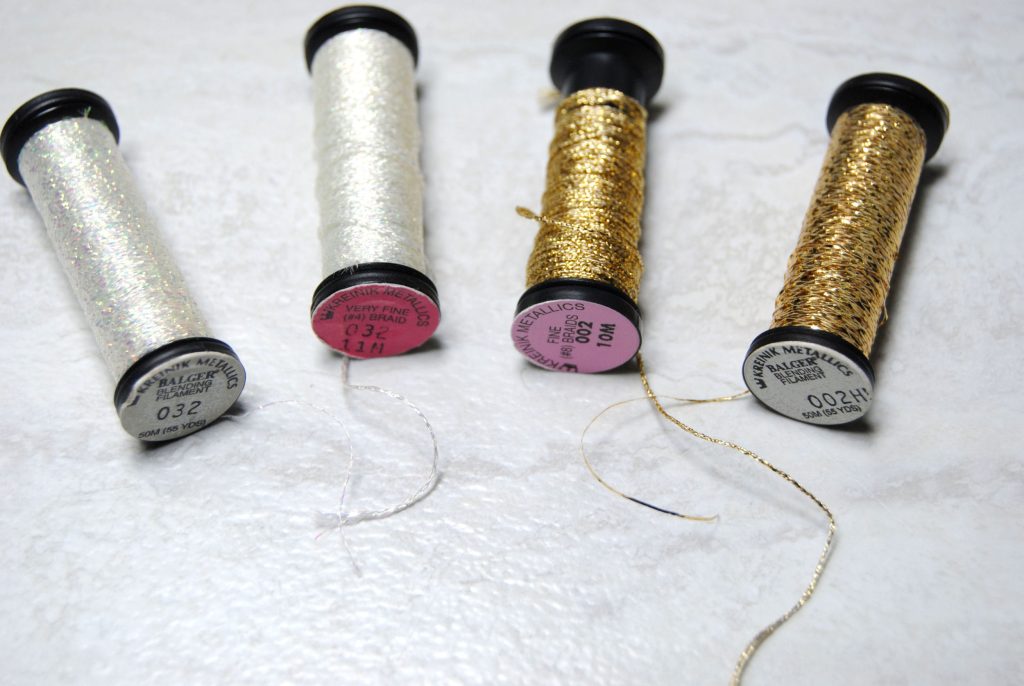
Blending Filament
If you’re curious about blending filament, I have a whole article devoted to its uses. But basically this is a very thin thread. It can be used on its own in certain applications, but typically used together with a stranded cotton thread to create unique color combinations. If you’re not sure how often you’ll really find a use for a specific color of metallic thread, consider blending filament instead. You can make all sorts of different colored blends with a single spool of filament.
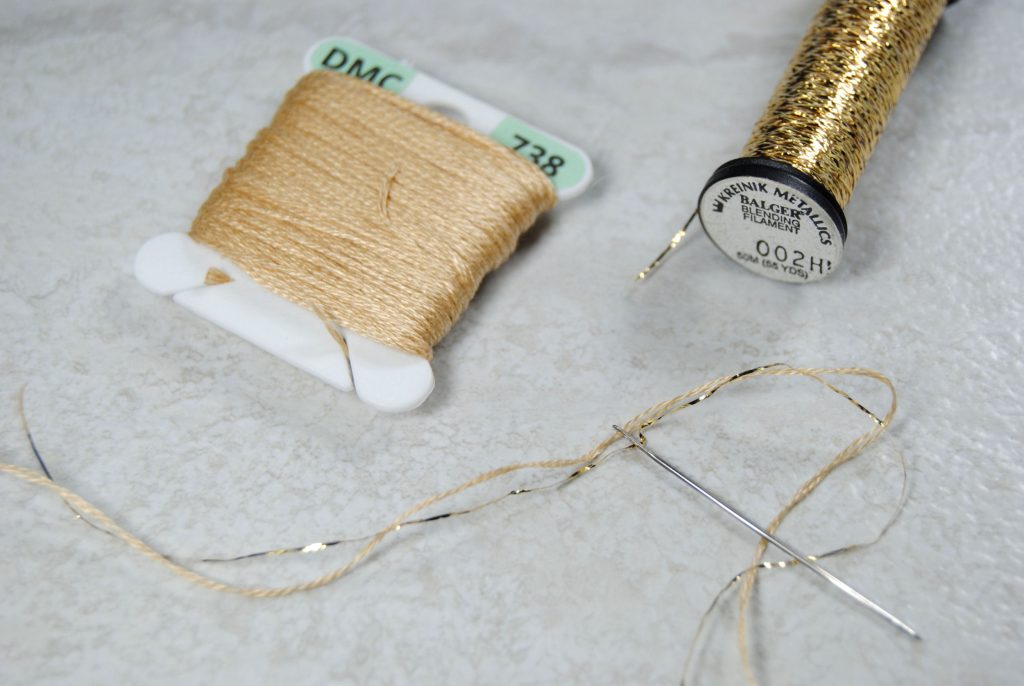
Cord
Metallic cord is available in various sizes, including the above #4 and #8. It’s a single strand thread that works great for backstitching and couching. I have not tried it myself just yet, but it has definitely come up numerous times over the years!
Other Sizes
Honestly, there’s too many sizes to list here. The above four are the most common used in cross stitch, but if you’re cross stitching on lower counts, such as 10 count plastic canvas you might consider going up to a 1/8″ or 1/16″ ribbon instead. For certain specialty stitches you might want a thicker braid or ribbon.
For a full breakdown as well as size suggestions for working Kreinik into other crafts, check out the Kreinik selection guide.
Ombre
The Kreinik Ombre threads are a different category of their own as it’s not a braid or cord. It’s an 8-ply twisted metallic. It’s about as thick as a #8 braid, but much softer. The texture reminds me of DMC’s Mouline Etoile series, if you’ve worked with that.
Most importantly, many of the colors in this line are variegated, making for fun transitions. Though it’s also available in plain silver, gold, pearl, or copper.
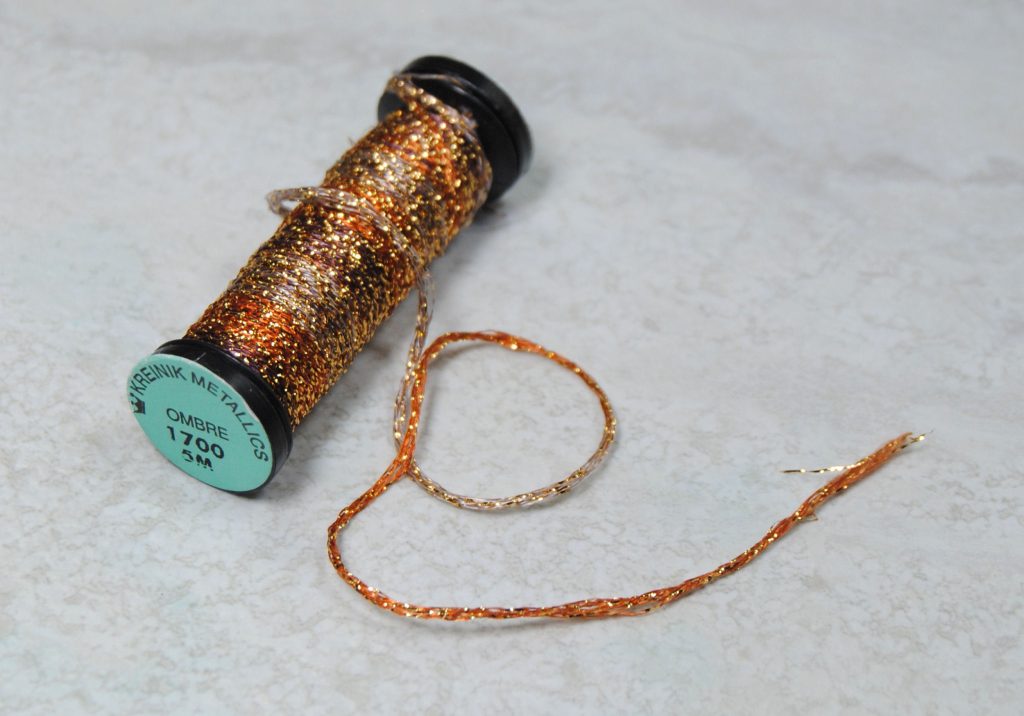
Silk Mori
Up until now we’ve been talking about metallic threads, as that’s what Kreinik is mainly known for. But did you know they have a whole line of Silk threads known as Kreinik Silk Mori? If you’re a fan of using silk thread in your cross stitch or embroidery, I’d love to know what you think of the Kreinik Silks. I haven’t picked any up myself yet but it’s definitely on my to-try list.
There’s also the Silk Serica and Silk Bella line if you typically work with pearl cotton.
The Kreinik Needle
That’s right, Kreinik makes needles too! It’s not strictly necessary in order to work with Kreinik thread. In fact I only discovered it existed while researching for this article. But it is a thing that exists and would be useful for cross stitch.
The Kreinik Needle comes in size 24 and 26, and has a “unique hard coating derived from Titanium”. That coating is meant to resist tarnishing and rust according to the Kreinik site. It also boasts a special eye “designed to make stitching with metallics easier”
This might also be useful for those of us with nickle allergies or hand oils that eat through metals. But I have obviously not tried them myself. If you go through standard needles quickly and try the Kreinik needle for yourself, let me know how it goes! I’ll update this article with your findings.
Coverage on Different Fabrics
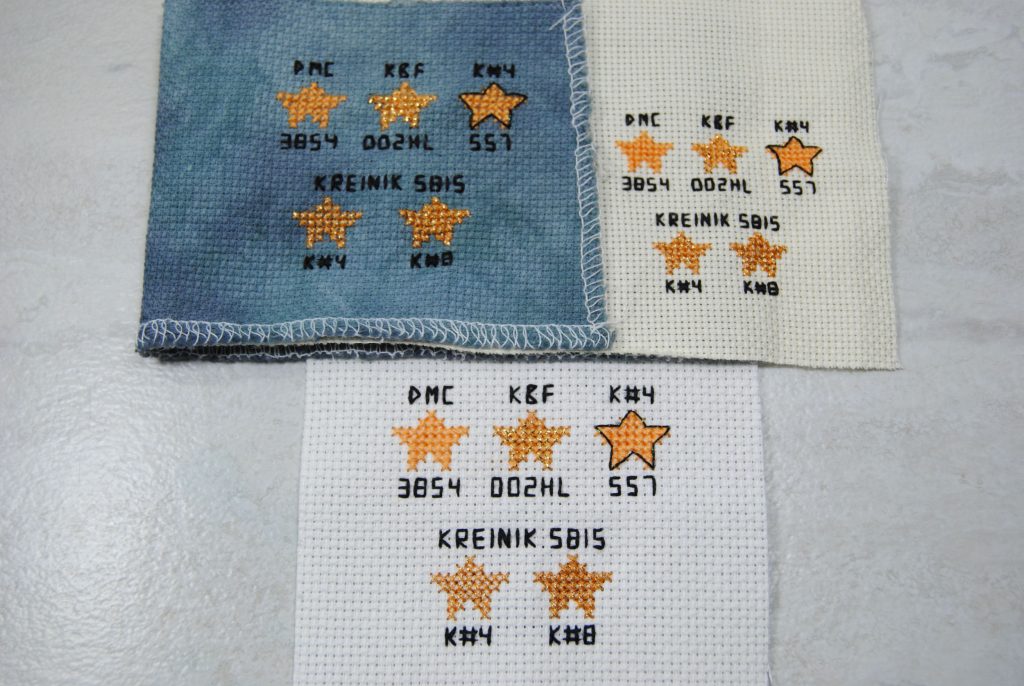
Now that we’ve explained the different sizes in words and numbers, let’s show them off visually. I went ahead and did some swatches for you on 14, 16, and 18 count!
- For the first star I used 2 strands of plain ol’ DMC so you can see how it compares to something you’re likely familiar to working with.
- The second star uses the same 2 strands of DMC 3854, but adds in a Kreinik blending filament in 002HL.
- The third star uses the same 2 strands of DMC again, but uses Kreinik #4 in color 557 as backstitch around it.
- Finally, the fourth and fifth stars are stitched in #4 and #8 respectively so you can compare the size of the two as it looks stitched.
I chose a braid color similar to the plain DMC I used so you can see how using a Kreinik braid compares to recreating a similar color with Blending Filament like in the second star.
Swatches!
Let’s get a closeup at each count:
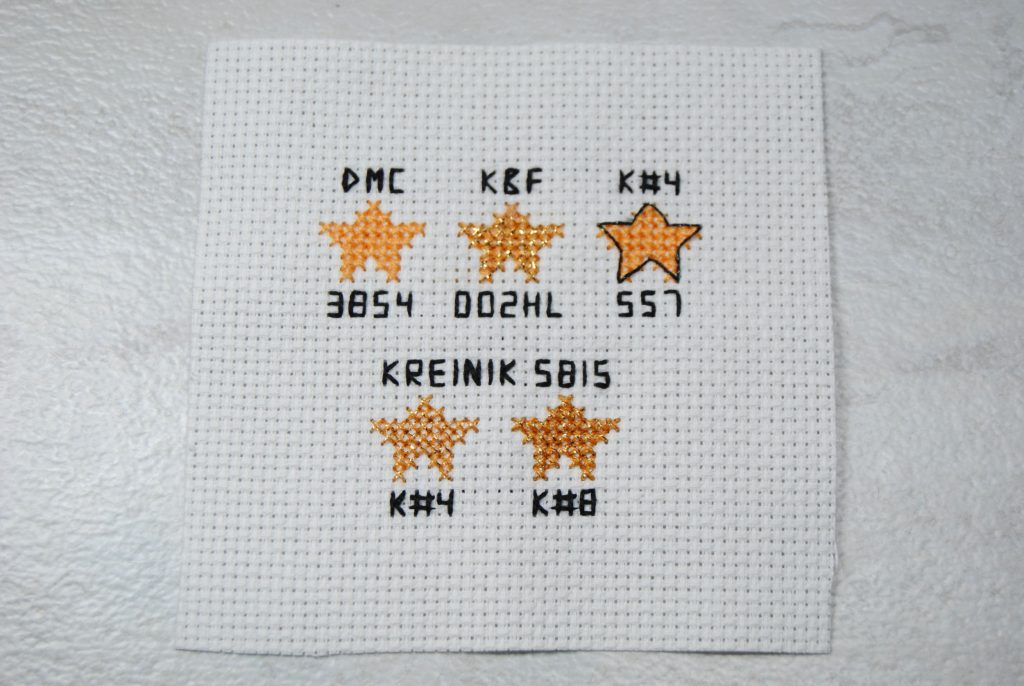
First on plain white 14 count aida. You can see that the #4 lets a little of the fabric in. So if you prefer fuller coverage, compare it with the #8. But that #4 makes for some great backstitch!
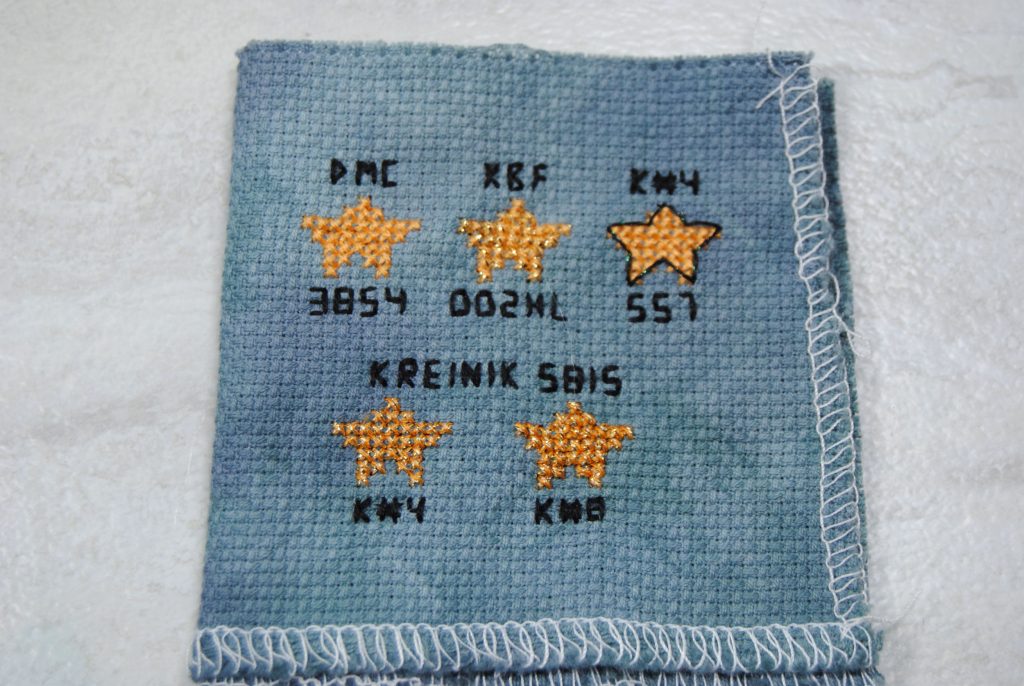
I didn’t have any plain white 16 count, so I stitched my swatches on this scrap of PictureThisPlus Dusk.
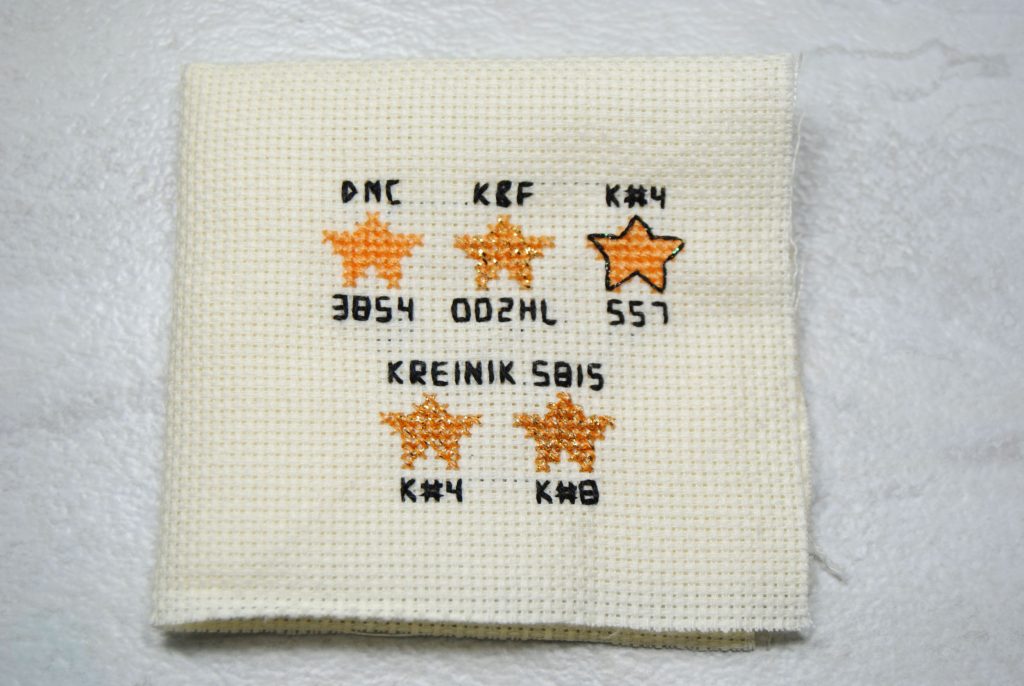
And my 18 count was a bit more of a cream off-white color, but you get the idea. I struggle stitching the #8 on this count though, so I’d recommend leaving that to lower counts.
Unfortunately I don’t have any Cord or Silk Mori to test for you, but hopefully this gives you a good idea of which of the other sizes you might like in your project depending on what fabric sizes you lean towards.
What Do the Letters Mean?
Sizing aside, you’ll also note that some colors are denoted by a simple number, while others have a letter as well. Sometimes you see the same number but with a letter attached. So what exactly the difference between 002, 002V, 002L, 002J, 002HL, and 002C for example?
Well the number is the actual color. In this example 002 tells you that these are all going to be Gold threads. But each letter denotes a different finish or material composition.
- C – Cord
- F – Fluorescent or Glow in the Dark
- HL – Hi Lustre
- J – Japan, created as a less expensive version of historical Japanese embroidery threads
- L – Holographic or prismatic
- V – Vintage, which are more muted
- W – Wired, which is a wired version of the #16 braid
You might even see a spool say Ombre, which is not a braid, but a 8-ply twisted thread.
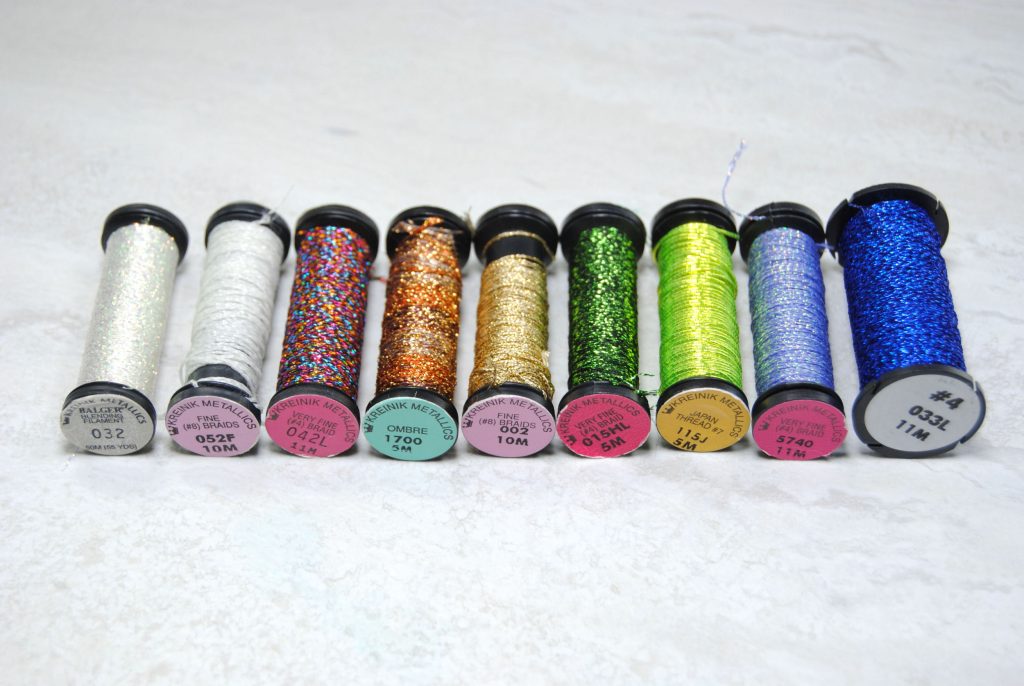
Old Spools vs New Spools
One thing to note is that most of the sizes used in cross stitch are the thinner ones. You don’t see as much couching or thicker ribbons as you might in embroidery. All the sizes I mentioned above previously came on the smaller spools. These spools also featured a little ‘lid’ that you could raise up to put your thread tail in and snap back down to hold it in place. You’ll see them in most of my photos.
However, since 2020 you’ll start finding these same threads on the larger spools, white spools, and now an entirely new type of larger spool without the snap lid.
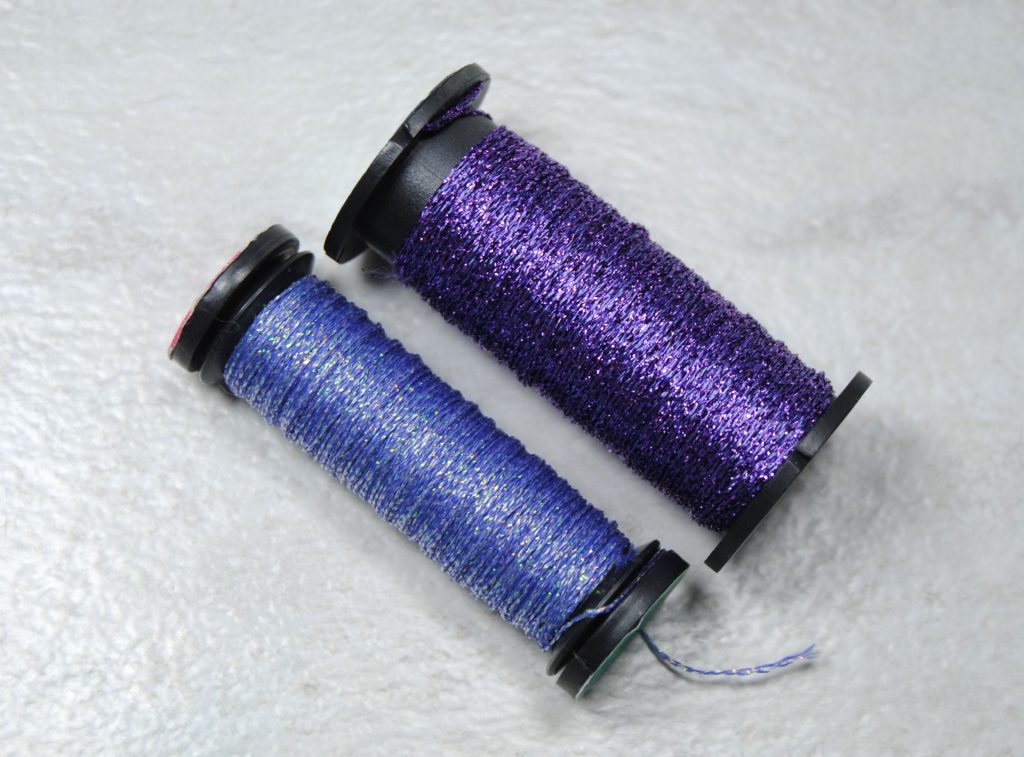
Why the new spools?
There’s a few reasons for this.
First, they had an issue with the mold used to create the smaller spools, and the plastic shortage raised the price of plastic. At that time they started spooling their thread onto whatever spools they had on hand, from putting thinner threads on the larger spools, to using up some white spools they had already manufactured.
Since then they’ve engineered a new type of spool, and all sizes going forward will be on this new larger spool. Instead of the snap lid, it features slits instead. These slits are on both ends of the spool and are in different sizes, to accommodate the different thicknesses of thread they offer.
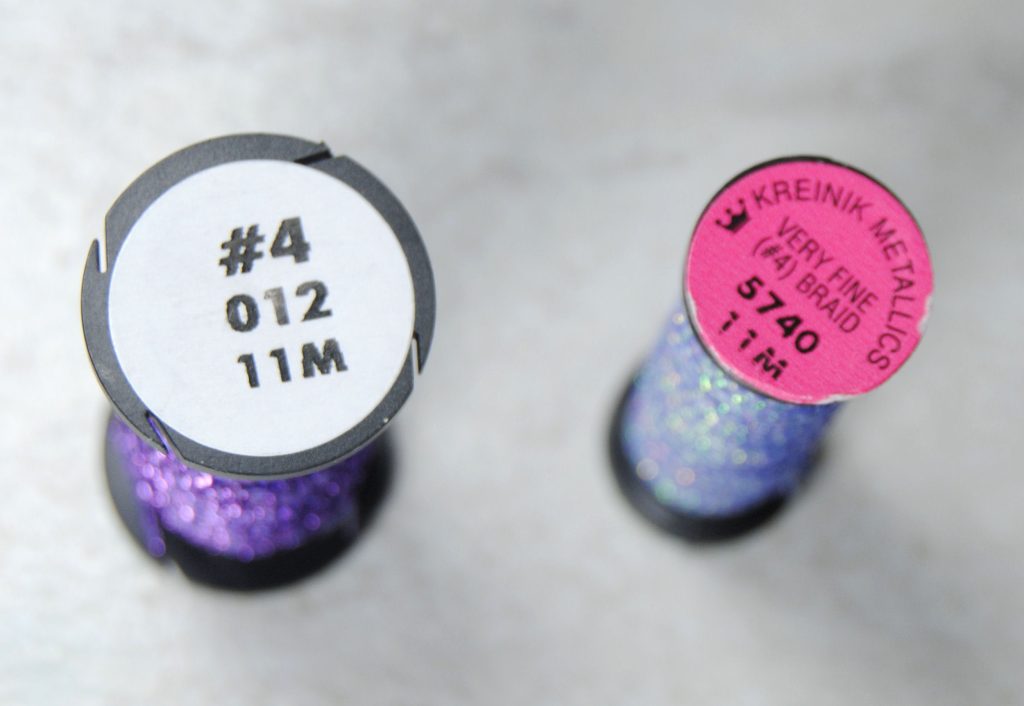
They’ve also switched to having all labels be white rather than being different colors depending on the size of the thread. The labels list the size, color, and length of thread but aren’t crowded by logos, instead the logo is on the green label on the other side of the spool. With the new spools not being as hollow on top and the new stickers seeming to be a bit stickier, they also stay attached a bit better. These new labels also feature a larger/thicker font which makes them a bit easier to read, too!
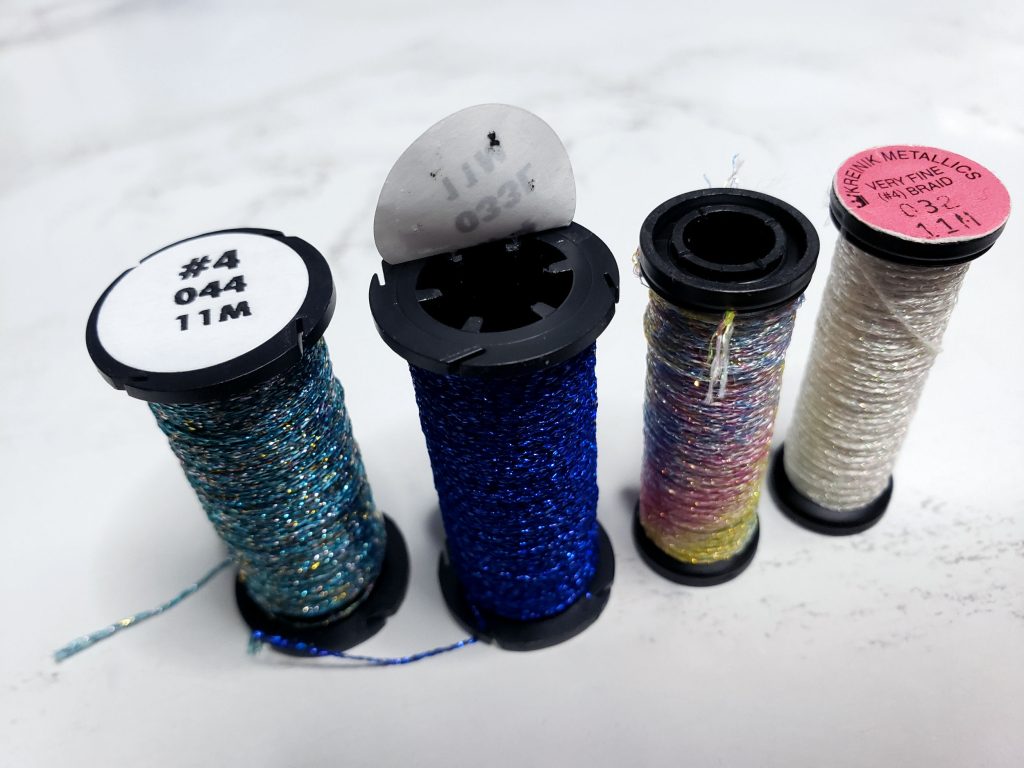
So, if your local shop has a mix of spools don’t worry, they’re all Kreinik. They’ve just gone through some changes!
Care & Storage
Washing
Generally speaking, Kreinik’s braids and ribbons are hand and machine washable. Note that some colors such as red may bleed. Do a swatch like the stars I did above and try washing it first before you wash your full project. I generally recommend that with any red threads you use regardless of brand, as it is notorious for being the most likely to bleed.
Ironing
As with any metallic threads it is recommended to NOT iron your metallics. These are synthetic fibers and can melt or simply shrink.
An example of this happened in my Sulky Glowy review. I accidentally ironed my project out of sheer habit! Sure enough, the Glowy thread completely melted away and had to be restitched before I could finish my project.
That said, if you do need to iron your project simply use a lower heat setting and use a press cloth as a buffer between your project and the iron.
Storage Options
You’re likely familiar with storing DMC thread, either on bobbins, floss drops, or leaving them as skeins. However, you may not be sure what to do with all these spools. So let’s go over a few options for you!
Bobbin Boxes
If you already store your bobbins in boxes, you might have a few extra compartments that could house a spool or two. As you collect Kreinik could even expand to fill a complete box of its own! I actually stored mine like this for a long time. The main issue I encountered was trying to find a specific one by number. Or having to pull out a stack to get at one on the bottom of the pile. But overall, it’s not a bad option. And cheap.
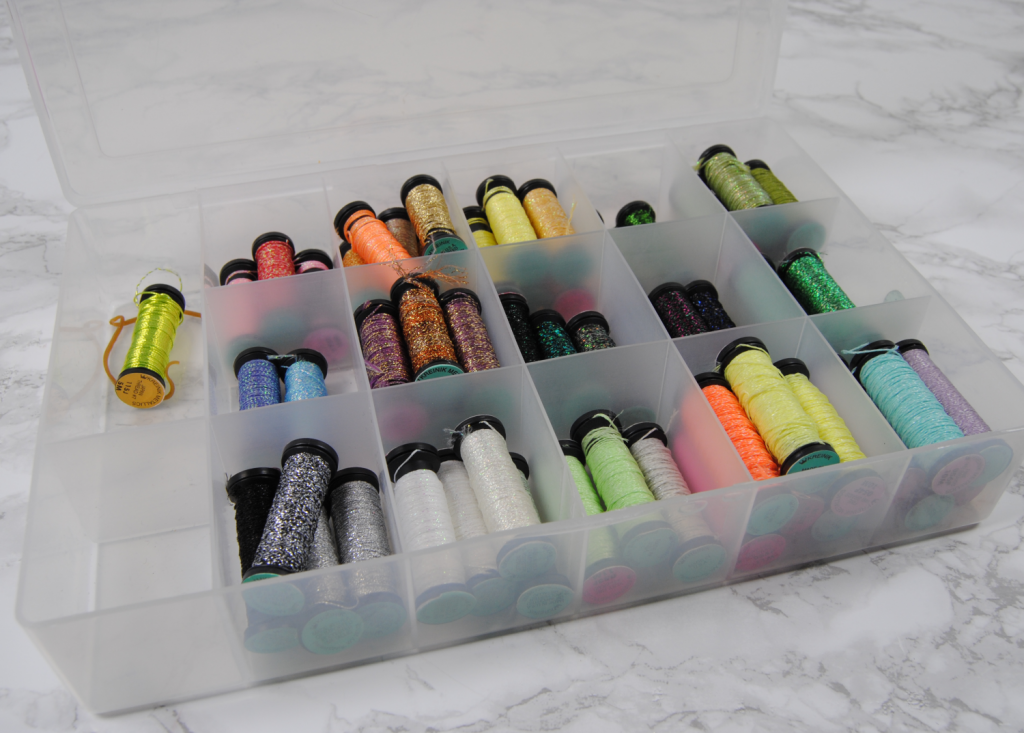
Spool Boxes
These are typically designed for sewing thread, but can easily be repurposed for Kreinik spools. I found a few examples of this in my searches. My favorite was the Gutermann spool box pictured on the blog Christin’s Ramblings. If you don’t have quite that many spools of Kreinik yet, they do come in smaller sizes as well.
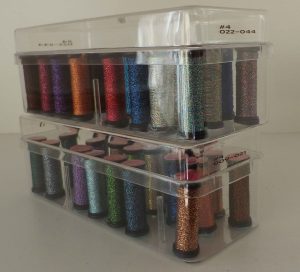
Currently the box I use is the Sulky Slimline Storage Box. This houses my Kreinik as well as the few other brands I have on spools. This includes Sulky, Nishikiito, Bijoux, and Accentuate.
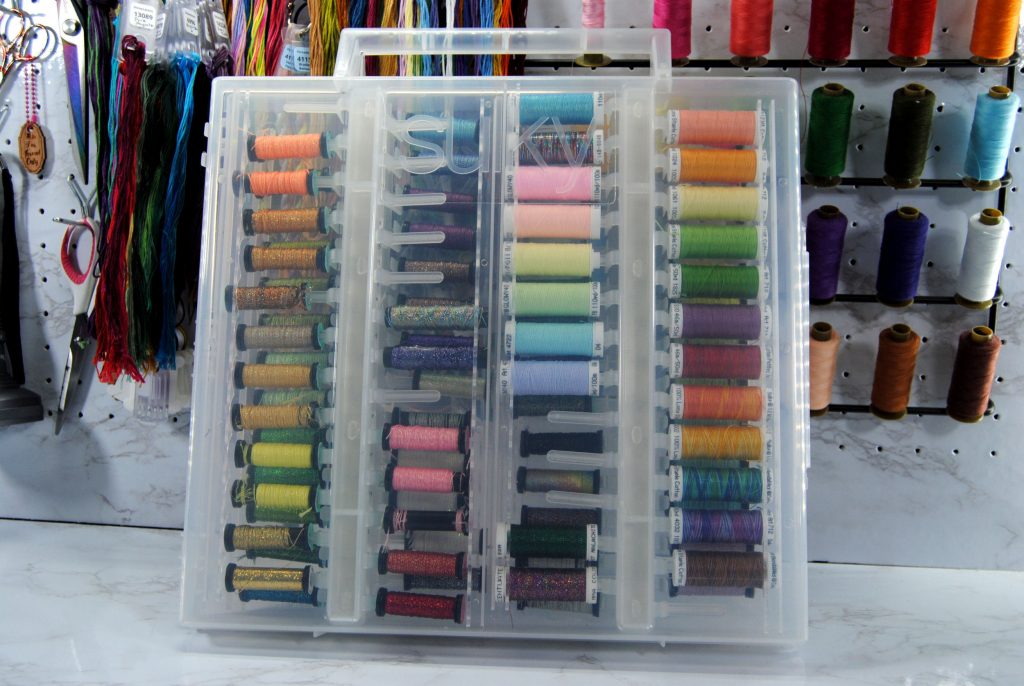
PipandChip also offer a tin specifically designed to store Kreinik spools as well. Though based on the listing photos at the time of writing this article, I don’t think it’s been updated for the new spool sizes yet.
Photo Boxes
I’ve mentioned these photo boxes before. I use them to store my duplicate DMC skeins that haven’t needed to be bobbined yet. But it turns out they’re decent Kreinik storage as well, as demonstrated by Needleartnut.
I can see where getting to ones on the bottom might get mildly annoying. Overall though, a great use of these photo boxes. Especially if you already have one of the large photo keepers for skeins and haven’t quite filled them yet.
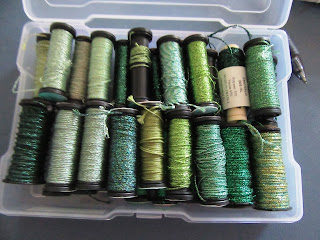
Ammo Boxes
Yep you heard that right. I don’t see these used as much these days since there’s a lot more options now. For a while though, the best storage hack for Kreinik spools was ammo boxes. Typing “Kreinik ammo box” into Google to find sizing info for this article even brought up a review on the Cabela website!
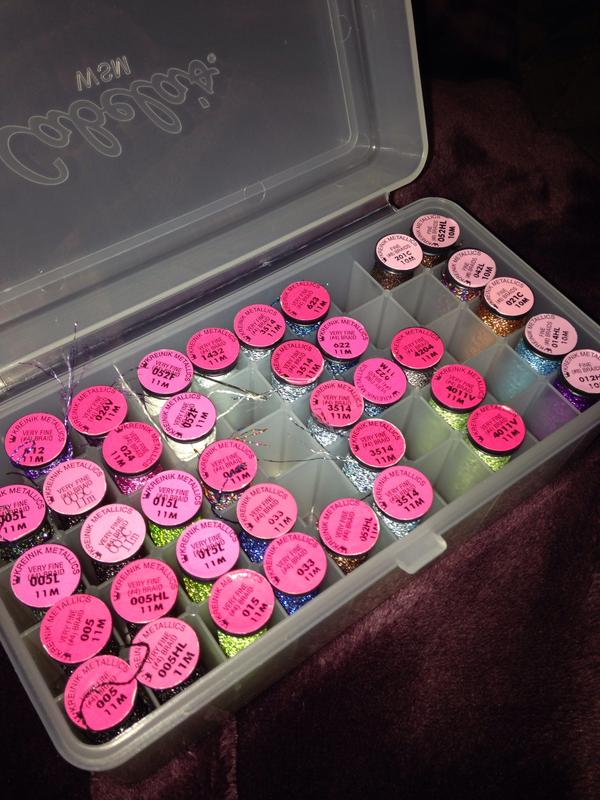
20 gauge shotgun boxes were the size being used, as mentioned in the blog Meari’s Musings, who shows off quite the collection of thread!
The downside here being that the spools being made now are larger and may no longer fit with this particular hack. I’m not familiar enough with firearms to know if they make larger shells and thus larger ammo boxes. But if you have a stash of small spools still, you might find this helpful!
Comparing to Other Brands
I wanted to spend some time listing off all the brands I could think of and comparing their prices, number of colors, and how easy they were to find and/or use. And then I realized just how long this article already was. So I’ve posted that list as a separate article, as that information can be useful regardless whether you’re considering Kreinik or some other brand.
So for that full breakdown, check my Metallic Thread Brand Comparisons article.
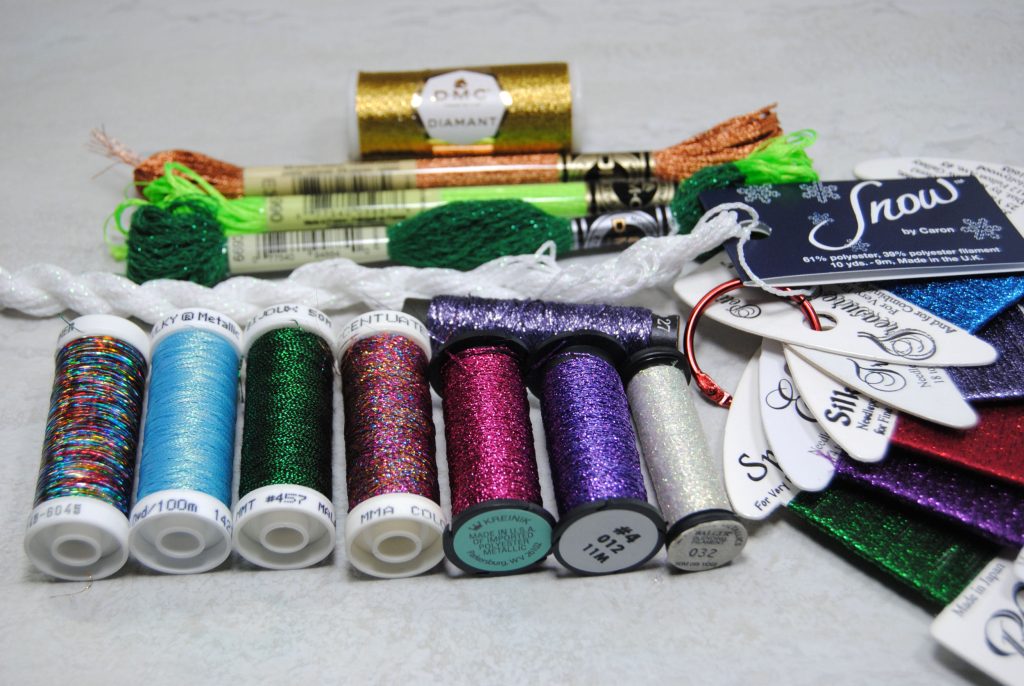
Color Conversion Charts
Even if your pattern doesn’t specifically call for Kreinik, it can be quite fun to add some sparkle by substituting in some of the colors of your design with some metallic threads.
Cotton Brands to Kreinik
To make that easier, Kreinik has some conversion charts available. If your pattern uses DMC thread, you can use the DMC Cotton to Kreinik conversion chart and substitute out any color that you think should sparkle. For example, white stars could sparkle by using 032 pearl or 100 white. You could convert the glow of a candle into metallics, or add some gold to your border motifs. Get creative!
Other Metallic Brands to Kreinik
It’s possible your pattern already calls for a different type of metallic thread but it’s not as easy to find, or you simply prefer Kreinik. You can find various conversion charts online.
Glissen Gloss Rainbow Thread to Kreinik
DMC has discontinued some of their metallic threads, so you can find substitutions for those in Kreinik as well. Here’s the Discontinued Light Effects and their Kreinik counterparts from my Discontinued DMC threads article:
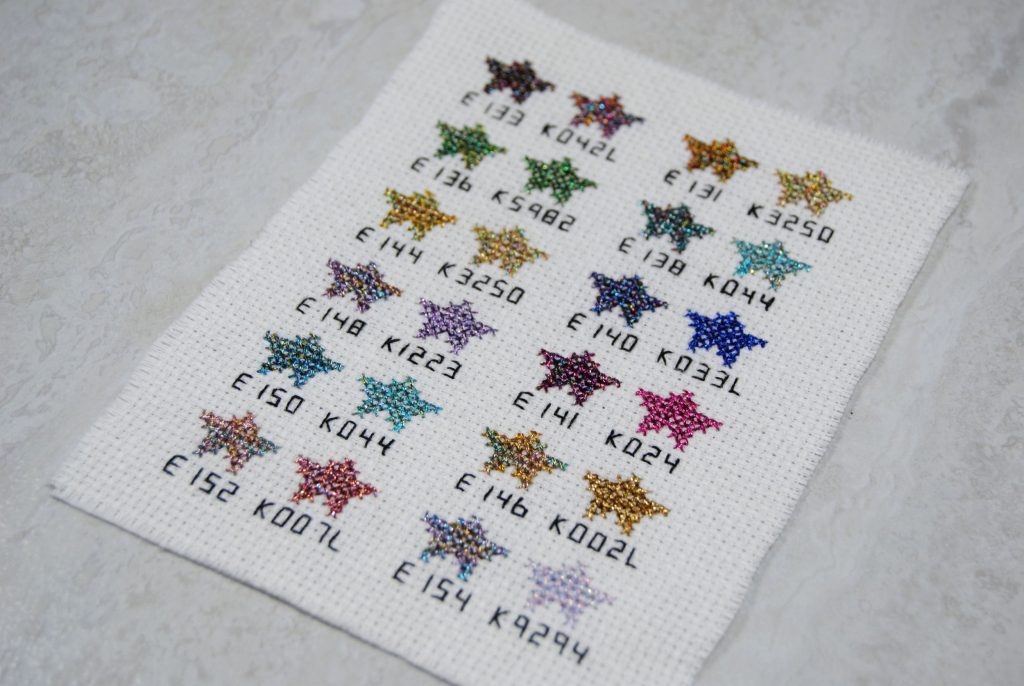
Other Silk Brands to Kreinik
There’s also various conversion charts for the Kreinik Silk Mori line!
There are charts for DMC, Anchor, and Pearl Cotton to Kreinik Silk, as well as Pearsalls and Soie d’Alger threads.
Discontinued Kreinik & Replacements
Just like any other brand, Kreinik has discontinued some of their colors over the years for various reasons.
Unlike certain brands, they are really good about announcing discontinued threads so that you know to stock up before they’re gone.
They’re also good at providing a list of all their former colors and the next closest Kreinik color you can use. I’m going to simply link to it, as it will be the most up to date reference at any time.
Discontinued Kreinik and their replacements
Designers That Use Kreinik
After all that, hopefully I’ve convinced you to give Kreinik a try. Whether you substitute in some sparkle on that pattern you’re already planning, or find a new one that was specifically designed with Kreinik in mind.
To get you started, here’s some examples of artists that regularly include Kreinik in their designs.
Classic Designers
Starting with the classic designers Mirabilia, Chatelaine, and Wentzler. If you’ve been around the community long enough you’ve likely heard these names.
Remember that with older patterns you may still find these threads referenced as ‘Balger.’
- Chatelaine is known for incredibly intricate mandala designs, full of metallic threads, beading, and specialty stitches. Sadly, she passed away in 2017, so no new designs will be coming. Her daughter Ela has taken up the business, so maybe one day we’ll see some designs under the Chatelaine in a new style!
- Wentzler has a very unique style, but is mostly known for her medieval designs. As these are no longer in print and her site has been taken down, you’re more likely to find her designs and kits on ebay or via online book shops. But they’re highly sought after, so probably won’t be cheap.
- Mirabilia has been a staple in the cross stitch community since the 90s and is known for elaborate mermaids and well dressed ladies. These often include specialty threads such as Kreinik as well as beading. You might also find designs under the name “Nora Corbett” This is the same artist, but are separate from the Mirabilia line.
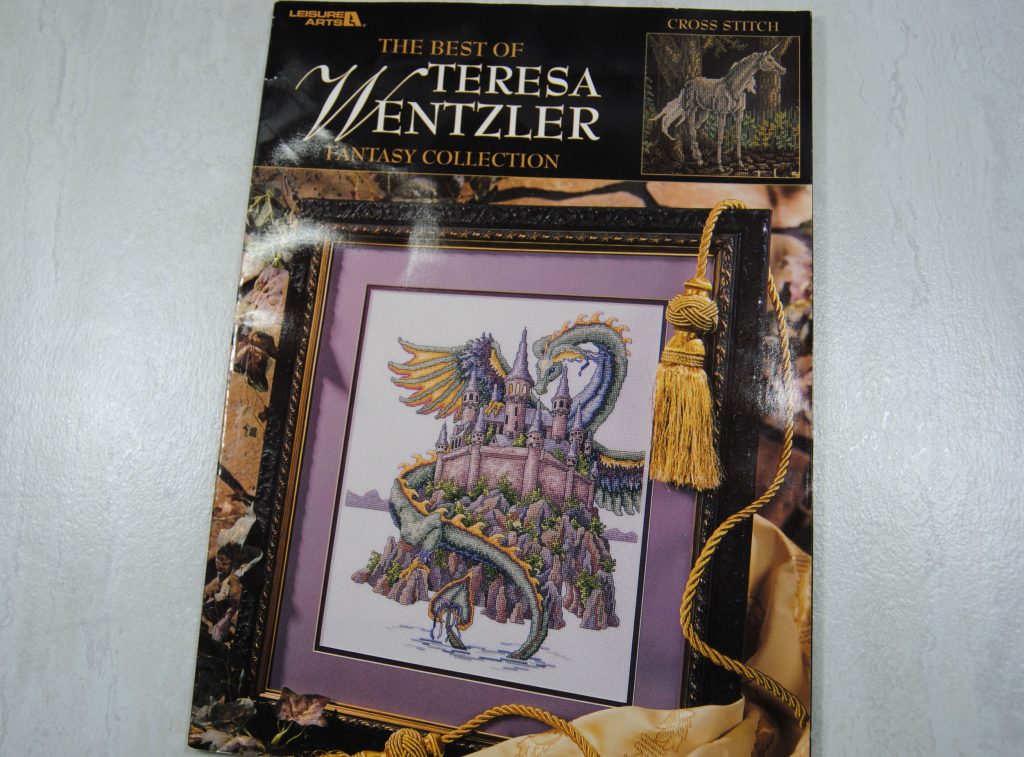
Modern Designers
Modern designers incorporate Kreinik as well, though! And by ‘modern’ I guess I just mean 2000s+? Is my millennial showing? Whoops. Anyway, here’s some other designers that use Kreinik wonderfully:
- If you like the idea of the Mirabilia ladies but haven’t quite found one that fits your style, check out Bella Filipina.
- If your style is a bit more on the nerdy side, or you’re a fan of Mucha, MakeitPink is a great place to start. Her conversions of Hanna Alexander’s Sailor Moon, Legend of Zelda, and Disney Princess designs are simply stunning. As well as Frenone’s World of Warcraft designs!
- If you’d like some smaller designs to start you out, look through the ShannonChristine site. Quite a few of them include Kreinik, such as her Fairy Garden collection.
- Some of HandsOnDesign’s patterns uses Kreinik as well. Such as the fun halloween-themed “Scary Apothecary” series.
- If you enjoy Flowers or biscornu, I highly recommend Faby Reilly as well, who uses both Kreinik and Rainbow Gallery threads in her designs.
Are you a designer? Consider picking up a Color Card too! They’ve got SO many colors to choose from and in different finishes that this will be absolutely invaluable in designing. I hope to pick one up myself someday.

